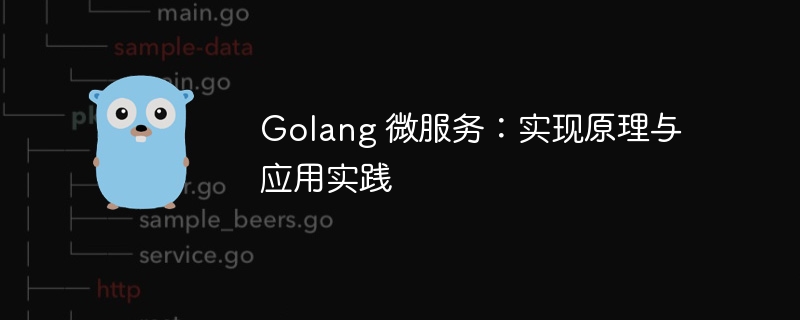 Backend Development
Backend Development
 Golang
Golang
 Golang microservices: implementation principles and application practices
Golang microservices: implementation principles and application practices
Golang microservices: implementation principles and application practices
Feb 29, 2024 pm 12:39 PM
"Golang Microservices: Implementation Principles and Application Practices"
With the development of cloud computing and containerization technology, microservice architecture is increasingly widely used in various software systems. As an efficient and lightweight programming language, Go language (Golang) also performs well in microservice development. This article will explore the implementation principles of Golang microservices and combine them with specific code examples for application practice.
1. Overview of Microservice Architecture
Microservice architecture is an architectural pattern that splits a software system into multiple small services that are independent and can be deployed independently. Each microservice focuses on completing specific business functions and achieves system flexibility, scalability and fault tolerance through lightweight communication mechanisms and independent deployment.
In a microservices architecture, communication between microservices usually occurs through HTTP, RPC, or message queues. Each microservice can use different programming languages and technology stacks to achieve optimal performance and efficiency.
2. Golang microservice implementation principle
Implementing microservices in Golang mainly relies on third-party libraries such as net/http packages and gorilla/mux provided in its standard library. The following are the basic steps to implement Golang microservices:
- Create HTTP server: Use the net/http package to create an HTTP server, listen to the specified port, and handle HTTP requests from clients.
- Routing and processor: Use routing libraries such as gorilla/mux to define routing rules and write processor functions to handle different HTTP requests.
- Data transmission format: Data transmission formats such as JSON or Protocol Buffers are usually used for data communication between microservices.
- Service registration and discovery: Use service registration centers (such as Consul, Etcd) to realize the registration and discovery of microservices to ensure reliable communication between each microservice.
3. Golang microservice application practice
Next, we use a simple example to demonstrate how to use Golang to implement a simple microservice. Suppose we want to implement a user management service, including the user's addition, deletion, modification and query functions.
1. Create HTTP server
package main
import (
"fmt"
"net/http"
"log"
)
func main() {
mux := http.NewServeMux()
mux.HandleFunc("/users", handleUsers)
server := &http.Server{
Addr: ":8080",
Handler: mux,
}
log.Fatal(server.ListenAndServe())
}
func handleUsers(w http.ResponseWriter, r *http.Request) {
switch r.Method {
case http.MethodGet:
// 处理查询用户列表的逻辑
case http.MethodPost:
// 处理创建用户的逻辑
case http.MethodPut:
// 处理更新用户的逻辑
case http.MethodDelete:
// 处理删除用户的逻辑
default:
w.WriteHeader(http.StatusMethodNotAllowed)
return
}
}2. Define routes and processors
mux.HandleFunc("/users", handleUsers)
3. Implement each interface method
Implement the query in the handleUsers function User, create user, update user and delete user logic.
Through the above steps, we can implement a simple user management microservice. Of course, in actual development, we also need to consider the implementation of exception handling, logging, security verification, etc. to ensure the stability and security of microservices.
Conclusion
This article introduces the implementation principles and application practices of Golang microservices, hoping to help readers better understand how to use Golang to build an efficient microservice system. Although microservices architecture offers many advantages, it also requires careful design and implementation to realize its maximum benefits. I hope everyone will continue to explore in practice and create a more robust and reliable software system.
The above is the detailed content of Golang microservices: implementation principles and application practices. For more information, please follow other related articles on the PHP Chinese website!

Hot Article

Hot tools Tags

Hot Article

Hot Article Tags

Notepad++7.3.1
Easy-to-use and free code editor

SublimeText3 Chinese version
Chinese version, very easy to use

Zend Studio 13.0.1
Powerful PHP integrated development environment

Dreamweaver CS6
Visual web development tools

SublimeText3 Mac version
God-level code editing software (SublimeText3)

Hot Topics
 How to configure connection pool for Golang database connection?
Jun 06, 2024 am 11:21 AM
How to configure connection pool for Golang database connection?
Jun 06, 2024 am 11:21 AM
How to configure connection pool for Golang database connection?
 How to safely read and write files using Golang?
Jun 06, 2024 pm 05:14 PM
How to safely read and write files using Golang?
Jun 06, 2024 pm 05:14 PM
How to safely read and write files using Golang?
 Similarities and Differences between Golang and C++
Jun 05, 2024 pm 06:12 PM
Similarities and Differences between Golang and C++
Jun 05, 2024 pm 06:12 PM
Similarities and Differences between Golang and C++
 How steep is the learning curve of golang framework architecture?
Jun 05, 2024 pm 06:59 PM
How steep is the learning curve of golang framework architecture?
Jun 05, 2024 pm 06:59 PM
How steep is the learning curve of golang framework architecture?
 Comparison of advantages and disadvantages of golang framework
Jun 05, 2024 pm 09:32 PM
Comparison of advantages and disadvantages of golang framework
Jun 05, 2024 pm 09:32 PM
Comparison of advantages and disadvantages of golang framework
 Create distributed systems using the Golang microservices framework
Jun 05, 2024 pm 06:36 PM
Create distributed systems using the Golang microservices framework
Jun 05, 2024 pm 06:36 PM
Create distributed systems using the Golang microservices framework
 What are the best practices for error handling in Golang framework?
Jun 05, 2024 pm 10:39 PM
What are the best practices for error handling in Golang framework?
Jun 05, 2024 pm 10:39 PM
What are the best practices for error handling in Golang framework?
 golang framework document usage instructions
Jun 05, 2024 pm 06:04 PM
golang framework document usage instructions
Jun 05, 2024 pm 06:04 PM
golang framework document usage instructions






